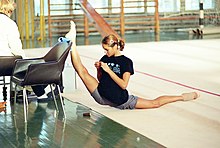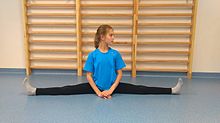Balancing act
A balancing act (from Italian : spaccata "straddle" or spaccare "splitting") is an acrobatics exercise in which someone spreads their legs so far that they form a straight line. The exercise occurs in various martial arts , in fitness and dance sports , in gymnastics , yoga as well as in ballet , vaulting , limbo skating and show dance .
to form

There are two forms of the balancing act:
- Cross split (longitudinal split / women's split)
- the leg is as straight forward as possible, i.e. spread away from the body; that is, with the left or right leg pointing forward and the other one pointing backward.
- Side splits (men's / men's split)
- in which both legs are spread sideways from the body; this species is similar to the straddle.
Each of the two forms can be performed standing on the floor, on one leg or in an inverted position ( handstand , headstand or forearm stand ). In the reverse posture, the legs are passively spread by your own body weight , in contrast to an active spreading through the strength of the leg muscles .
An overspagat is understood as the fact that the legs are spread even wider during the cross-split so that they form an obtuse angle . This can be achieved, for example, by resting the feet on objects, such as doing a split between two chairs.
metaphor
In German, the term is often used in a figurative sense to express that someone tries to bridge two (mostly argumentative, but also spatially) opposing positions. Example: A manager manages / tries the balancing act between his family in Hamburg and his overtime at the company in Munich.
